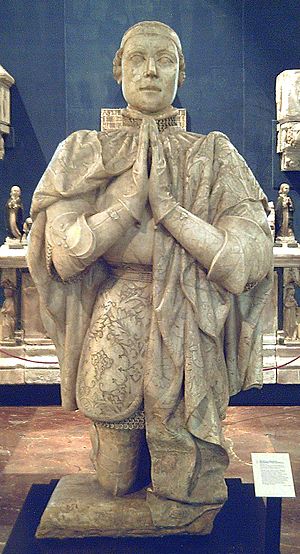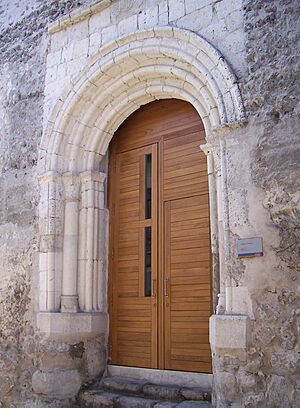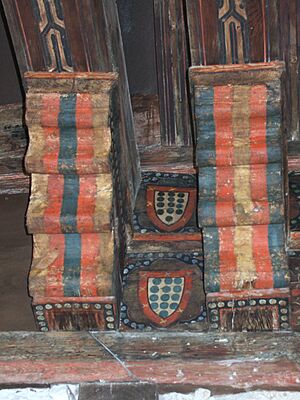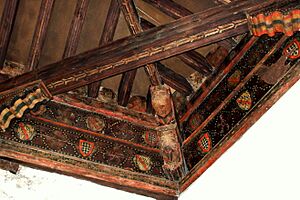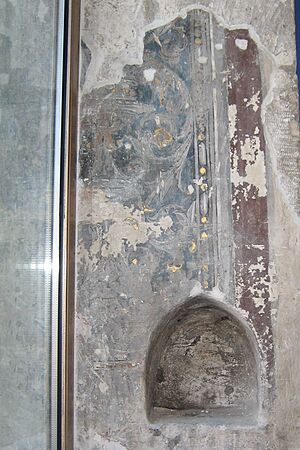Palace of Peter the Cruel, Cuéllar facts for kids
Quick facts for kids Palace of Don Peter The Cruel |
|
|---|---|
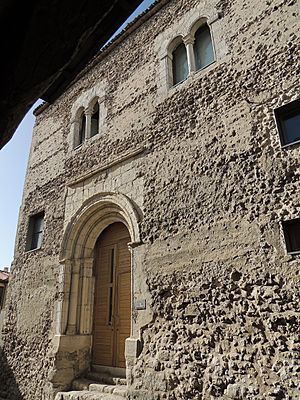
|
|
| Location | |
| Built | 14th century - 20th century |
The Palace of Peter the Cruel is also known as the Palace of the Velázquez or Casa de la Torre. It is a very old building from the 13th century with Romanesque features. You can find it in the town of Cuéllar, in the province of Segovia, Spain.
This palace was the main family home of the Velázquez de Cuéllar family. From the 17th century, they called it the Casa de la Torre, meaning "House of the Tower". Today, it's famous as the "Palace of Peter I" because King Peter I of Castile held his wedding celebration here in 1354. He married Juana de Castro in this very building.
The palace was officially recognized as an important historical site on July 20, 1974. This means it is protected for its historical value.
Contents
A Look at the Palace's History
The first records of the palace date back to the year 1348. At that time, Don Juan Manuel gave the building to Elvira Blázquez. She was the wife of Pedro González Dávila. Her family, the Velázquez of Cuéllar, became very important in Cuéllar.
The palace was part of the family's property for many years. It was passed down through generations. First, it went to the Counts of Cobatillas. Later, it belonged to the Marquises of Vellosillo. In the 17th century, Louis Jerome de Contreras y Velázquez de Cuéllar owned it.
The Velázquez family kept the palace until the confiscation by Mendizábal. After that, it was owned by the family of the poetess Alfonsa de la Torre. In the early 20th century, the palace was used as a chicory factory for many decades. This was a common fate for old buildings in the town.
Alfonsa de la Torre later inherited the palace. She wanted it to become a cultural center named after her. After some discussions, the City Council of Cuéllar bought the property in 1998. They started restoration work in 1999. In 2002, with help from the Junta of Castile and León, the palace was fully restored. It cost about 650,910 euros. In 2005, it opened as a Business Incubator for young business owners. It also has a hall for cultural events.
Peter I of Castile and the Palace
The palace is now known by Peter I's name because of his connection to it. King Peter I had a complicated personal life. He was married to Blanche of Bourbon. However, he wanted to end that marriage.
In April 1354, Peter I married Juana de Castro y Ponce de León in Cuéllar. The wedding took place at the Church of St. Martin. The celebration banquet was held at this palace. It was chosen because it was the most suitable building for such an important event.
However, Peter I's new marriage did not last long. Stories say that the day after the wedding, the king left Juana de Castro. He went to Castrojeriz because of urgent news about another person he cared about, María de Padilla. Even so, Juana de Castro kept the title of queen for the rest of her life. She lived in her castle in Dueñas, which was part of her wedding gifts.
Exploring the Palace's Design
The palace is located near Calle del Colegio. This street connects the Main Square with the Bread Market. So, it's right in the middle of the town's historic area. It is a great example of romanesque art. Many historians believe it is one of the best-preserved civil palaces from that time in Spain.
Outside the Palace
To imagine how the palace looked long ago, we can read a description from 1662. It said:
This house has two towers, large walls of ashlar and masonry and the main room has its main doorway of ashlar stone with three columns on each side, and ends in an arch, and above the first cornice there are three small targets, as of half a rod: the one in the middle and those of the sides as of a third and in the one in the middle there are thirteen roels that are carved in stone, which are the arms of the Velázquez and on the right side on the other card there are five fleurs-de-lis that are the arms of the Xixones, and to the left side on the other card that as the past ones is of stone there are five castles and a vaston that divides the quarteles crosses it and near the tower there are two shields above a pillar that divides two narrow windows and in it there are other two shields of the same size, one with the arms of the Velázquez and another with those of the Salinas. The tower that is to the right is unguarded and ruined and the one that is to the left side of the door is a strong tower, guarded and with square of weapons and has its diverse windows with its stone columns.
—Jesús Larios Martín, Volume II, p. 504.
Today, the palace looks different from its original design. The old description mentions two towers, one on each side. It also talks about a small walled area. One of the towers is now gone. The wall that once surrounded the palace is also missing. However, recent digs have found parts of an old wall nearby.
The building has two main floors. The tower also has its own levels. The windows on the upper floors are double. They have semicircular arches and a central column. This column has a capital decorated with plant designs.
Family Symbols and Coats of Arms
The palace has a wide stone front. The main entrance has a semicircular arch with decorative carvings and columns. These columns are adorned with snake designs. Above the arch, there are three heraldic coats of arms. From left to right, they show the symbols of the Velázquez, Gijón, and Velasco families. The first one belongs to the palace's owners. The other two show family connections through marriage.
The 1662 description mentions five more coats of arms that are no longer there. Inside the palace, you can find two more stone coats of arms. There are also about a hundred more painted coats of arms. These often repeat the symbols of the Velázquez and Velasco families.
Here are some of the family symbols you can see:
- Velázquez: A silver shield with thirteen blue circles. It has a red border with eight golden blades.
- Velasco: A checkered pattern of gold and blue-grey pieces. It has a diagonal bar crossing it.
- Gijon: A blue shield with five golden fleurs-de-lis arranged in a cross shape.
- Salinas: A silver shield with an oak tree and two black wolves at its base. It has a red border with eight black blades.
Inside the Palace
On the ground floor, there are two large rooms. They are separated by a wall with a well-made stone doorway. Facing the main door, you'll see another facade inside the palace. It has another semicircular arch with carvings and columns. Above it are two small shields. These shields are worn, so we can't see the symbols clearly. They likely showed the Velázquez and Velasco family symbols. This inner door leads to a large garden. Before entering the garden, on the left, there's an old well that supplied water to the palace. Upstairs, you can see parts of a fireplace that warmed the room in winter.
The second floor holds the main hall. This is the most important part of the palace. It also has parts of a fireplace and stone benches by the windows. There's also a niche with geometric patterns. Near the entrance, a straight staircase leads up to the tower.
The top floor of the tower has four large windows. From here, you get a full 360-degree view of the town. You can even see the vast pine forests in the distance.
Colorful Decorations (Polychrome)
In the main hall on the second floor, you can see small colorful designs on the wooden ceiling. The main hall also has parts of a beautiful painted and carved ceiling. This ceiling was restored in 2006.
The restoration work revealed geometric patterns. These are mixed with the coats of arms of the Velázquez and Velasco families. There are also carved wooden heads at the corners of the ceiling.
Based on the coats of arms and painting style, we think Juan Velázquez de Cuéllar and his wife, María de Velasco y Guevara, had these decorations made. Juan Velázquez was an important person during the time of the Catholic Monarchs. He was a trusted servant and held many important positions. He and his wife also raised St. Ignatius of Loyola for a time.
You can also find colorful heraldic designs on the staircase leading to the tower. In one of the rooms on the second floor, there are small parts of wall paintings. These help us imagine how colorful the palace walls once were.
See also
 In Spanish: Palacio de Pedro I el Cruel (Cuéllar) para niños
In Spanish: Palacio de Pedro I el Cruel (Cuéllar) para niños


